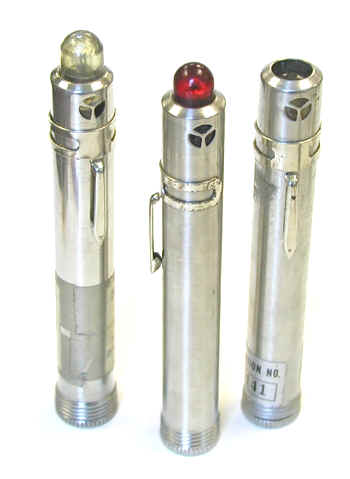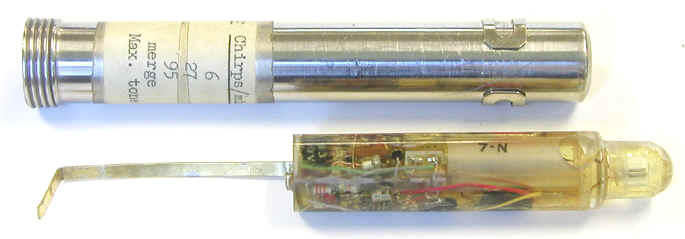ORNL Personal Radiation Monitors (ca. 1960-1965)

Shiny stainless steel cases and flashing lights, what more could you ask for in a dosimeter? Designed at Oak Ridge National Laboratory (ORNL) in the late 1950s, they employed a miniature GM tube, speaker, and transistorized electronics. With the exception of the light and battery, all the components were encased in an epoxy block.
In addition to an audio output (a chirping sound that came out of the small circular opening just above the pocket clip at the top of the dosimeter case), some versions also employed a visual signal. To work properly, the opening of the sound port in the plastic block needed to be aligned with the hole in the case. If the unit has a light, the chirps and light flashes are produced simultaneously.
The dosimeters shown in the photograph to the left were manufactured at ORNL. One has a red light, one has a white light, and the third version has no light.
"For use as a warning device and to indicate relative intensities of photon radiation. This instrument is useful primarily because of its sensitivity and its audio-visual characteristics." (ORNL Health Physics Instrument Manual).

In 1960/1961, several companies obtained the rights to manufacture commercial versions of the ORNL dosimeter: Atomic Accessories (the “Chirpee”), NUMEC (PRM-1, PRM-2), Landsverk (Model L-135 and L-135A), REAC (the SCRAM), and Victoreen. The following photograph shows the SCRAM-1 which was produced by Radiation Equipment and Accessories Corporation (REAC) of Lynbrook, New York. While the other commercial versions looked almost exactly the same as the original ORNL version, the REAC dosimeter had a couple of unique features. First, it had a dark gray enameled case rather than stainless steel. Second, the audio signal came out the top of the unit rather that the side.

The photograph below shows the "Chirpee" produced by Atomic Accessories.

Below is a photo of Nuclear Associate's PRIMA I (as in Personal Radiation Monitor) donated by Bill Fendt.

I heard the following story from one of the developers of this device. During Senator John Fitzgerald Kennedy’s tour of Oak Ridge National Laboratory in 1959 (shortly after he announced he would be running for the presidency), he visited the instrumentation group where he was shown the dosimeter. Later, when JFK had gone, the lab folks noticed that the dosimeter had disappeared, presumably swiped by the future president. I also heard that JFK carried one of these when he went overseas to meet with Khrushchev. The concern was that there might be some type of attempt to expose the president to harmful levels of radiation. This might sound farfetched but this was also the time when the CIA attempted to kill Castro with exploding cigars.
The following AP press release dates from December 1960: "Development of a new type radiation protection instrument called the personal radiation monitor has been announced. The device, about the size of a fountain pen and weighing only 3 1/2 ounces, emits a warning tone and flashes a small light in the presence of a gamma radiation field. Scientists here Monday said its greatest value would be in the immediate warning it would give in a radiation accident."
The original ORNL version, which had no On/Off switch, had a battery life of 20 to 30 days with continuous operation. To extend its useful life, the battery was supposed to be removed when the dosimeter was not being used. At least some of the commercial versions (e.g., the Atomic Accessories unit) had a mercury switch that would turn the dosimeter off when it was placed in a horizontal position.
Range: Varied with manufactured and model, e.g., 0-2 R/hr, 0-10 R/hr, 0-200 R/hr
Size: 5.5” long and 0.75” in diameter
Weight: 3.5 ounces
Battery: One 4 volt (TR 133N), 4.2 volt NEDA 1304
References
- Nucleonics September 1961 p 90.
- Nucleonics September 1961 p 124.
- Nucleonics October 1961 p 36N.
- Davis, D.M., Gupton, E.D. Health Physics Instrument Manual. ORNL-332 (rev.) Feb. 1970.
- AP press release. New Audible Radiation Detector Announced. Appeared in the December 13, 1960 issue of the Great Bend Daily Tribune.
